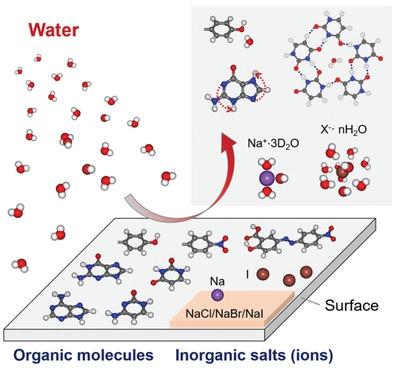Our official English website, www.x-mol.net, welcomes your
feedback! (Note: you will need to create a separate account there.)
Interactions between water and organic molecules or inorganic salts on surfaces
Aggregate ( IF 13.9 ) Pub Date : 2022-02-08 , DOI: 10.1002/agt2.175 Chi Zhang 1 , Wei Xu 1
Aggregate ( IF 13.9 ) Pub Date : 2022-02-08 , DOI: 10.1002/agt2.175 Chi Zhang 1 , Wei Xu 1
Affiliation

|
Water, as a ubiquitous and relatively inert medium, plays a vital role in nature. The interactions between water and organic molecules or inorganic salts are of fundamental interest in understanding hydration processes in chemistry. The combination of scanning probe microscopy and theoretical calculations provides a versatile tool to directly visualize and further rationalize such interactions as well as influences of water on organic molecules and inorganic salts. In this review, we provide a brief overview of the recent exciting progress in revealing the interactions between water and organic molecules as well as inorganic salts (including ions) on surfaces. Herein, we describe first steps of hydration of organic molecules followed by a microsolvation process on surfaces. Subsequently, water-induced tautomerization and chiral separation of small biomolecules on surfaces are discussed for understanding the roles of water in driving biological self-assembly processes. Moreover, water is also able to assist structural transformation globally by selectively interrupting the relatively weak hydrogen bonds within nanostructures. Based on the water-incorporated molecular nanostructures, dissolution of sodium halides on wet surfaces is achievable using confined water, while hydrates of halide ions desorb from the surface. More interestingly, ion hydrates are also demonstrated to be artificially accessible, which enables atomic-scale investigation into local ion hydration and transport at interfaces. This review provides new insights into the role of water in the hydration-related molecular and ionic systems, with implications for hydration and solvent effects down to the single-molecule level.
中文翻译:

水与表面上的有机分子或无机盐之间的相互作用
水作为一种普遍存在且相对惰性的介质,在自然界中起着至关重要的作用。水与有机分子或无机盐之间的相互作用对于理解化学中的水合过程具有根本意义。扫描探针显微镜和理论计算的结合提供了一种通用工具,可以直接可视化和进一步合理化这种相互作用以及水对有机分子和无机盐的影响。在这篇综述中,我们简要概述了最近在揭示水和有机分子以及表面上的无机盐(包括离子)之间的相互作用方面取得的令人兴奋的进展。在这里,我们描述了有机分子水合的第一步,然后是表面上的微溶剂化过程。随后,讨论了水诱导的小生物分子在表面上的互变异构化和手性分离,以了解水在驱动生物自组装过程中的作用。此外,水还能够通过选择性地中断纳米结构内相对较弱的氢键来帮助整体结构转变。基于水结合的分子纳米结构,卤化钠在潮湿表面上的溶解可以使用受限水实现,而卤化物离子的水合物则从表面解吸。更有趣的是,离子水合物也被证明是人工可接近的,这使得对界面处的局部离子水合和传输进行原子级研究成为可能。这篇综述为水在与水合相关的分子和离子系统中的作用提供了新的见解,
更新日期:2022-02-08
中文翻译:

水与表面上的有机分子或无机盐之间的相互作用
水作为一种普遍存在且相对惰性的介质,在自然界中起着至关重要的作用。水与有机分子或无机盐之间的相互作用对于理解化学中的水合过程具有根本意义。扫描探针显微镜和理论计算的结合提供了一种通用工具,可以直接可视化和进一步合理化这种相互作用以及水对有机分子和无机盐的影响。在这篇综述中,我们简要概述了最近在揭示水和有机分子以及表面上的无机盐(包括离子)之间的相互作用方面取得的令人兴奋的进展。在这里,我们描述了有机分子水合的第一步,然后是表面上的微溶剂化过程。随后,讨论了水诱导的小生物分子在表面上的互变异构化和手性分离,以了解水在驱动生物自组装过程中的作用。此外,水还能够通过选择性地中断纳米结构内相对较弱的氢键来帮助整体结构转变。基于水结合的分子纳米结构,卤化钠在潮湿表面上的溶解可以使用受限水实现,而卤化物离子的水合物则从表面解吸。更有趣的是,离子水合物也被证明是人工可接近的,这使得对界面处的局部离子水合和传输进行原子级研究成为可能。这篇综述为水在与水合相关的分子和离子系统中的作用提供了新的见解,


















































 京公网安备 11010802027423号
京公网安备 11010802027423号